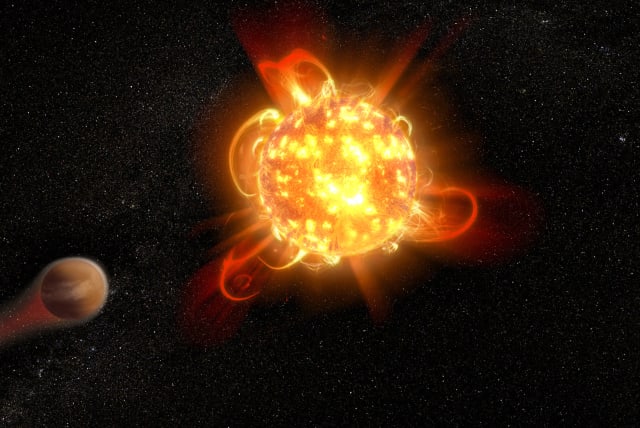NASA's Hubble Telescope records evaporating planet hiccupping during orbits

This variable loss was described as "puffs", meaning that when observed the atmosphere was lost in large bursts followed by almost no loss.
The Hubble Telescope detected unusual changes in the loss of atmosphere for a planet orbiting the red dwarf star AU Microscopii (AU Mic), NASA announced on Thursday.
The research has been peer-reviewed and was published in The Astronomical Journal on July 23, 2023.
NASA observed the planet, called AU Mic b, as it orbited around the red dwarf, when the planet went from having no detectable loss of atmosphere to having a highly detectable loss of atmosphere. This extreme change shocked the astronomers.
This variable loss was described as "puffs", meaning that when observed the atmosphere was lost in large bursts followed by almost no loss.
"This frankly strange observation is kind of a stress-test case for the modeling and the physics about planetary evolution. This observation is so cool because we're getting to probe this interplay between the star and the planet that is really at the most extreme," said Keighly Rockcliffe of Dartmouth College.
AU Mic is located 32 lightyears from Earth and is one of the youngest planetary systems ever observed. The star itself is less than 100 million years old compared to our own Sun which is 4.6 billion years old. AU Mic b is just 6 million miles (just under 10 million km.) from its star, one-tenth of the distance from Mercury to the Sun, meaning it takes just 8.46 days to complete one orbit. AU Mic b is also four times the diameter of Earth.
The loss of atmosphere is caused by powerful stellar flares which are intense magnetic fields that become entangled in their star's own atmosphere. If this entanglement is too intense, stellar flares from AU Mic can release energy that is 100 to 1,000 times more energetic than our Sun's releases.
What is causing the "hiccups"?
As of yet, exact explanations for this "hiccup" are not confirmed, and several explanations are possible, including that the magnetic field is constantly "roiling" meaning it is highly unpredictable, and that this is the hiccuping.
Another explanation could be that the hiccupping may just be an optical illusion where at certain points the flares photoionize the escaping hydrogen, leading to it being invisible to the detection equipment.
Yet a final explanation is that the stellar wind itself is shaping the outflow making it detectable at some times and undetectable at other times, although this would be the first observation of such a phenomenon.
The research is important for understanding how planets develop and whether they will be able to hold life.
Jerusalem Post Store
`; document.getElementById("linkPremium").innerHTML = cont; var divWithLink = document.getElementById("premium-link"); if (divWithLink !== null && divWithLink !== 'undefined') { divWithLink.style.border = "solid 1px #cb0f3e"; divWithLink.style.textAlign = "center"; divWithLink.style.marginBottom = "15px"; divWithLink.style.marginTop = "15px"; divWithLink.style.width = "100%"; divWithLink.style.backgroundColor = "#122952"; divWithLink.style.color = "#ffffff"; divWithLink.style.lineHeight = "1.5"; } } (function (v, i) { });
